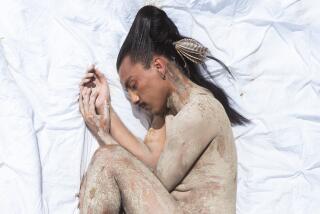Scenes of a world caught dreaming
- Share via
IMAGINE a world where there are no judgments, no slurs or “bad” words; a place where women move in independence, where age and sexual orientation are moot; where time has adopted a different meter and language is a convergence of deeply understood gestures -- a transcendent place where past, future and present merge for one-sixtieth of a second.
This is no figment of the imagination. These are the truths that have taken form in photographer Graciela Iturbide’s eye.
For more than 30 years, Iturbide has been working in the realms of dust, sweat, concrete, chain-link and bleaching sun, unearthing pride, self-confidence, love, eroticism, persistence, survival and the delicate process of self-definition in those who live in the ambiguity of the margins. Her gaze is without judgment, imbued with empathy, bringing the unseen into focus. In small villages in Mexico, she’s absorbed the emotional push-pull of la frontera, which echoes again in the day-to-day rituals of East Los Angeles gangs. Near the border and in the inscrutable landscapes of Florida, Louisiana and Mississippi, she’s created photographs that eloquently capture what it means to occupy an undefined space, the land of the unnoticed or passed by.
Her images inhabit the province of dreams: The mundane is upended by a juxtaposition, an anachronism -- a woman in near silhouette, dressed in what appears to be a traditional costume, descends a hill into a spreading valley, improbably carrying a boom box. A simple tilt of the frame shifts the plane -- and our way of seeing the world and ourselves.
A student of photographer Manuel Alvarez Bravo and perhaps most famous for a prodigious, alluring body of work made over six years in the remote village of Juchitan in Oaxaca, Iturbide, 65, has had a prolific career and has shown all over the world. This month, however, marks her first museum exhibition in Los Angeles. “Danza de la Cabrita (The Goat’s Dance)” at the Getty Center contains nearly 140 pieces highlighting Iturbide’s work in Mexico and the U.S. -- and the line in the sand that attempts to separate the overlapping lives she’s found there. “The Mexican and the American Mexican,” says Iturbide, “are marginal people -- on both sides of that line.”
Her work expresses “the culture between the culture,” says author Luis Rodriguez, who has also been pulled to the worlds that call to Iturbide -- Oaxaca and of course the East L.A. gangs he became famous for writing about in his memoir “Always Running.” “It’s the way I think of Mexico when I’m in Mexico City. You feel all the layers -- the ancient, the indigenous, the modern all coming together. Her photographs are borderless. Everything comes streaming over it. No border, no wall will stop that.”
While her work reflects an amalgam of influences -- there are echoes of Mexican printmakers and muralists and a slithery sense of surrealism -- Iturbide has long been led by a deep certainty she can’t consciously calibrate. “I like the surprise,” she says, lighting on a padded bench in the Getty gallery, surrounded by almost four decades of work. Her short, spiked hair is slightly windblown, but her gaze is fixed -- she’s the picture of calm given that she arrived only hours ago from Mexico City, just in time to see the last frame placed. “If I walk the streets in Rome, in Mexico, in Paris, for me the most important thing is the passion and the surprise that comes with it.”
The surprises can be anywhere: on the street, in the tray, on a forgotten contact sheet where she discovers an image that had somehow eluded her. You could call the magic intuition, chance, luck. Echoing Cartier-Bresson and his decisive moment, she calls it “the necessary instant.”
Much of Iturbide’s life has been marked by necessary instants both tragic and transcendent. The oldest of 13 children born into an upper-middle-class family in Mexico City, Iturbide started on the road to a traditional life. She was married at 19 and soon had children. Still harboring creative desires, she enrolled at the Centro Universitario de Estudios Cinemagraphicos in 1969, thinking she would study screenwriting. In 1970, however, her daughter, Claudia, died suddenly at age 6. She found solace in a course in still photography taught by Alvarez Bravo. As luck or necessary instants would have it, she was the only pupil. Soon, she wasn’t simply the student but the assistant-cum-apprentice, her “classes” conducted at Alvarez Bravo’s home. “We talked about art and literature, music and painting,” she says. “He’d put on Bach and we’d listen. And if I would say, ‘Oh, Maestro, how would you make that print?’ He would say: ‘Kodak has literature in the package telling you how.’ He was a special, special teacher. And for me there was no one in my life like that.”
What she absorbed couldn’t be taught precisely. It’s what she felt in him, in his work: “I loved the poetry and the time of Manuel Alvarez Bravo. Mexican time. In his studio he had a piece of paper up that said, “A Tiempo.” For me that was very important. You need to take it slow: to see slowly, to learn slowly. I work slowly.”
She began collecting images close to home -- “fiestas in little towns,” the street theater of Mexico City, “just one photograph of a fiesta, maybe another of the center.”
But it was Juchitan that would unleash her. In 1979, the artist Francisco Toledo invited her to photograph the Zapotec women in his hometown, one of Mexico’s oldest indigenous communities, where women are economically, politically and sexually self-governing. “In Juchitan it is not quite a matriarchy, but it is like one,” she explains. “Because the woman is the center of the economy.”
Far different from the rigid culture she grew up in around in Mexico City, this remote, ancient community showed Iturbide larger ways of being in and navigating the world. And with Toldeo as her calling card, she had no problem gaining entree.
Rose Shoshana, director of Santa Monica’s Rose Gallery, who began exhibiting Iturbide in the early ‘90s, was early on struck by “the strength with which she photographed women. And seeing this dance that was going on between them. Really, there was no distance. They were doing this together.”
One of her most iconic and frequently reproduced images -- “Our Lady of the Iguanas” -- features a regal Tehuana woman shot from below, with a cluster of iguanas, like a crown, on her head. She’d asked the woman, who had arrived at the market with the iguanas to sell, if she might make a portrait. “I took 12 frames, and only one of them was good, where the iguanas all looked up.”
Perhaps such surprises are the reward of persistence wrapped with courtesy: For Iturbide it is “ask, never take.” What’s most important is “complicity with the people,” that they be part of the writing of this story.
Journeys of discovery
Peering into the folds of the culture, seeking out what was “hidden away,” opened up a new avenue for thinking and working -- for good. “Juchitan opened my heart and opened my mind,” she says. She’s spent time among the Seri Indians in the Sonoran Desert and shooting goat-slaughtering rituals in Oaxaca. There have been journeys to Spain and Africa.
Over time, her work has scraped at sensitive skin, says Ruben Ortiz Torres, professor of photography at UC San Diego, for “both good and bad.” “Graciela made these very poetic representations with a strong, subjective point of view, which at some point has been criticized as being too romanticized,” says Ortiz. “But I have to say that . . . it might be true that she constructed a cliche, but it’s a very difficult cliche to separate because it is seductive. And it probably has to do with her more than poetics or mysticism.”
In various situations -- traveling with Cesar Chavez and Dolores Huerta and migrant workers, slipping into the life of East L.A. gang culture -- she’s been captivated by a visual conversation that loops back and forth between the Mexican in Mexico and the Mexican in America, observing how Mexico is imprinted on America.
“Cholos en Tijuana” depicts young Mexican boys mimicking the Mexican American cholo, down to the hairnet and the pleated trousers. In “Cholas, White Fence, East L.A.,” the women of White Fence (some deaf) throw gang signs as they pose in front of figures from Mexican history -- Juarez, Zapata, Villa -- none of whom they recognize. “They thought they were mariachis,” she says.
For all the proximity, the strength of the yearning embrace, there is vast distance between reality and fantasy: “These people live in the United States, but they have a nostalgia for Mexico,” says Iturbide. “They have the Virgen de Guadalupe on tattoos and on the wall. It’s everywhere. And it is incredible to me because . . . in Mexico, we have many problems -- we have poverty, no jobs -- but it is idealized here” in the U.S.
And the same holds for the Mexican nationals who long for the U.S. “Many, many Mexicans get turned back, but they come back again, again anyway,” she says. “To come to the United States is like a dream. The only dream.”
Iturbide has looked deeply into the dreams of her subjects, locating something essential they all share. Her images honor the transvestites of Juchitan, the cholas of East L.A. in all their theatrical self-presentation. “Identity” for them has a great elasticity, as she sees it. That is the gift of a life on the margins.
Iturbide’s subjects “want to stand out,” says the show’s curator, Judith Keller. “They want to make a big statement. I think she admires that. She is certainly on the margins herself -- as woman, as a petite woman in the arts. There is a fearlessness and bravery and this determination to go where it is she needs to go to get the material she’s interested in.”
Perhaps that’s what creates the startling, urgent yet difficult-to-pinpoint quality of her work, an element that shares close space with the beauty. It’s that independent soul through which she navigates these worlds. “Photography is not objective. It’s subjective,” says Iturbide, engraving her story. “So Juchitan is my Juchitan, not Juchitan, and the United States is not the United States. It’s my United States.” Perhaps it’s even that open, in-between space we call dreams: “We dream,” she says, “and sometimes that dream is found in the streets. In life.”
--
More to Read
The biggest entertainment stories
Get our big stories about Hollywood, film, television, music, arts, culture and more right in your inbox as soon as they publish.
You may occasionally receive promotional content from the Los Angeles Times.










